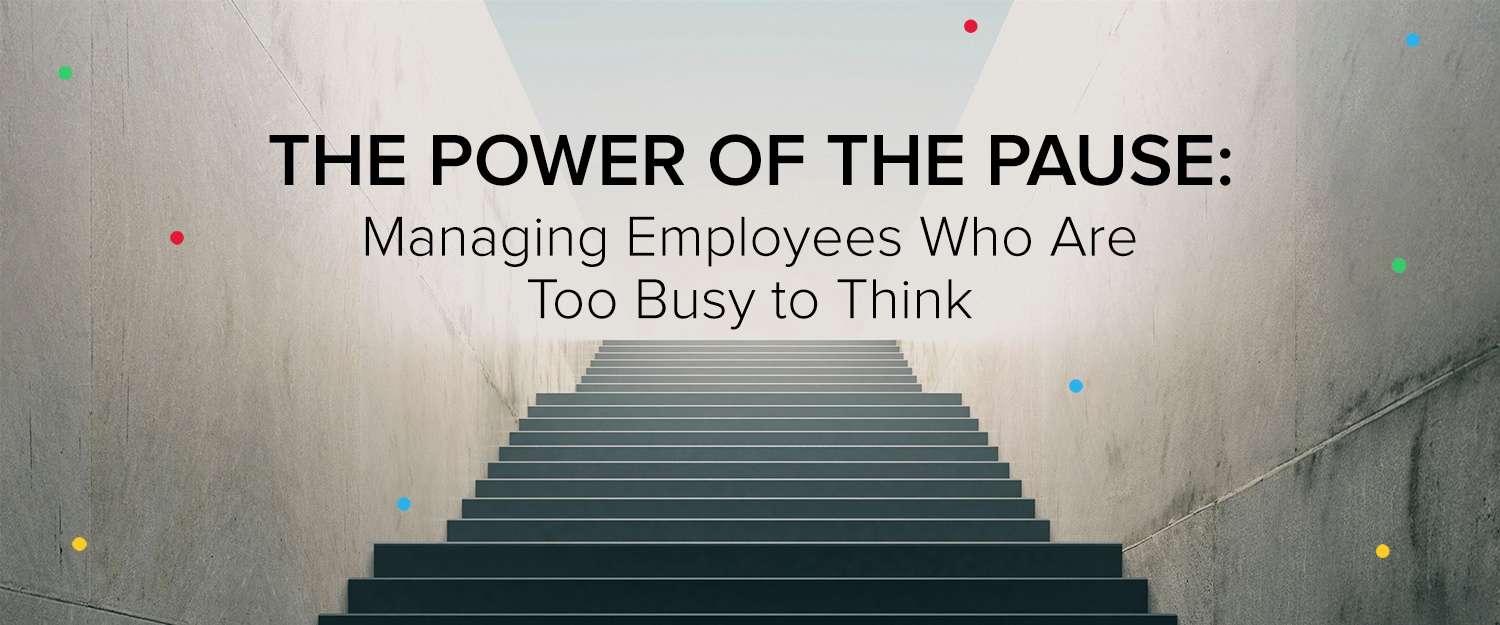They’re some of your most dedicated, hardest working employees. No one gets down to business and gets every box checked, every time, on time, quite like they do. Frankly, it’s a relief, knowing that you can count on them to keep plowing ahead no matter what you throw their way.
But did you ever stop to think that maybe they don’t have time to stop to think?
Deep thinking is in short supply in today’s work environment, where the distractions are many, the work is intense and task-oriented productivity rules the day. As a result, though, we’re sacrificing impact for activity. If people don’t have time to think more critically and intentionally, to make conscious choices instead of habitually reacting and responding, the business is going to suffer—maybe not today, but soon enough.
Just as important, so will your employees. All that doing doing doing will eventually lead to burnout, but even before it gets to that point, some of your most talented people will likely start looking around for greener pastures. Because let’s face it, your most talented employees want to use their brains! The endless to-do list doesn’t leave much room for making the mental connections to come up with new ideas, anticipate future opportunities or challenges, and do the deep thinking necessary to navigate complex work in a truly effective way.
If you’re a leader, empowering people to get things done is essential; but so is sanctioning the time for a regular mental pause. Here are some ways you can help your employees fit more deep thinking time into their routines.
1. Stop and think about your own process. Deep thinking starts with you. If you’re mindlessly assigning out work and relying on your “go-to” team members to make sure nothing falls through the cracks, it doesn’t matter what you tell people; your actions will counteract your best laid plans.
By thinking through how you allocate work, you’ll be able to optimize the way work gets done, freeing up more thinking time for everyone. Consider:
- What are the mental requirements of this task or project?
- What thinkers on my team are best suited to it?
- What other tasks and projects are each of my team members responsible for?
- What are the longer term goals we need to achieve in addition to the urgent or day-to-day work?
- How might I reallocate team resources to make the best fit?
View the process like a puzzle, where all of the different pieces need to fit together just right. An assessment like the HBDI can give you the data to solve the puzzle faster.
2. Challenge your assumptions about who your “go-to” employees are. The HBDI can also reveal patterns and similarities in the way you and your “go-to” employees think. It’s not uncommon to quickly connect with and trust people who think like we do, but you may be overlooking or discounting what different thinkers bring to the table, even if unconsciously. Again, this means taking a mental pause yourself. Don’t just assume no one else can do it the way you like it done. You may even find that someone else has a better way.
That said, if one or two team members are truly the only ones you can rely on, and they’re always picking up the slack for everyone else, then you have a performance issue that needs to be addressed. Don’t let it fester. Eventually, your star employees are going to get tired of pulling the weight for everyone else.
3. Help your employees embrace the power of the mental pause. When you have a team of driven, high achievers, it’s not always easy to get them to take a timeout for thinking. Some will worry that if they’re not doing, then it will look like they’re goofing off. It’s up to you to make deep thinking time a cultural standard, something that is necessary to the health of the business, the team and each individual.
This may require some ground rules to cut out the constant stimulus we’ve all become accustomed to. Some companies institute no-meeting days or schedule “email blackout” times. It could be something as simple as a tech-free lunchtime walk outside, or some “stop and think” cues to make sure something should be done before diving in and doing it. Encourage your team members to schedule and protect their (and their colleagues’) deep thinking time, even if it’s just 15 minutes a day. And make sure you honor it, too.
Sign up to our newsletter for the latest insights
Give employees the opportunity to take a step back and think about their thinking, to go beneath the surface and find out how their habitual patterns and reactions affect their behavior, attention and work. Once they understand this, they can begin to act by choice rather than reacting by default.
The stoic philosopher and Roman emperor Marcus Aurelius famously said, “You have power over your mind—not outside events. Realize this, and you will find strength.” When your team leverages the power of the mental pause, you’ll have more than just completed to-do lists to show for it. You’ll have better results and a healthier, more fulfilled team.












